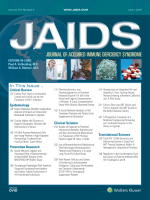Posted on May 01, 2017
Source: Journal of Acquired Immune Deficiency Syndrome

Lamivudine monotherapy-based cART is efficacious for HBV treatment in HIV/HBV co-infection when baseline HBV DNA<20,000IU/ml
Yijia LI, M.D., Jing XIE, Ph.D., Yang HAN, Ph.D., Huanling WANG, M.D., Ting ZHU, B.S., Nidan WANG, Ph.D., Wei LV, M.D., Fuping GUO, M.D., Zhifeng QIU, Ph.D., Yanling LI, B.S., Shanshan DU, B.S., Xiaojing SONG, B.S., Chloe L THIO, M.D., and Taisheng LI, M.D., Ph.D.
Background
Although combination antiretroviral therapy (cART) including tenofovir (TDF)+lamivudine (3TC) or emtricitabine (FTC) is recommended for treatment of HIV/HBV co-infected patients, TDF is unavailable in some resource-limited areas. Some data suggest that 3TC monotherapy-based cART may be effective in patients with low pre-treatment HBV DNA.
Go to:
Methods
Prospective study of 151 Chinese HIV/HBV co-infected subjects of whom 60 received 3TC-based cART and 91 received TDF+3TC-based cART. Factors associated with HBV DNA suppression at 24 and 48 weeks, including anti-HBV drugs, baseline HBV DNA, and baseline CD4 cell count, were evaluated overall and stratified by baseline HBV DNA using Poisson regression with a robust error variance.
Go to:
Results
Baseline HBV DNA≥20,000 IU/ml was present in 48.3% and 44.0% of subjects in the 3TC and TDF groups, respectively (P=0.60). After 48 weeks of treatment, HBV DNA suppression rates were similar between these two groups (96.8% vs. 98.0% for 3TC and TDF+3TC, P>0.999) in subjects with baseline HBV DNA<20,000 IU/ml; while in those with baseline HBV DNA ≥20,000 IU/ml, TDF+3TC was associated with higher suppression rates (34.5% vs. 72.5% in 3TC and TDF+3TC groups, respectively, P=0.002). In stratified multivariate regression, TDF use (RR 1.98, P=0.010) and baseline HBV DNA (per 1 log increase in IU/ml, RR 0.74, P<0.001) were associated with HBV DNA suppression only when baseline HBV DNA≥20,000IU/ml.
Go to:
Conclusion
This study suggests that 3TC monotherapy-based cART is efficacious for HBV treatment through 48 weeks in HIV/HBV co-infection when baseline HBV DNA<20,000IU/ml. Studies with long-term follow-up are warranted to determine if this finding persists.